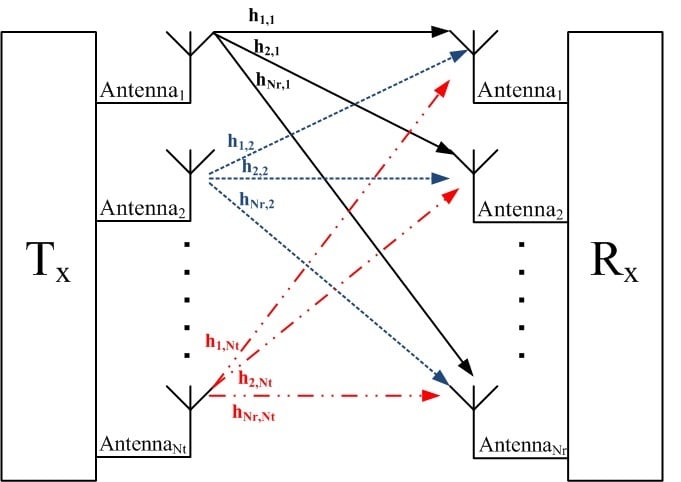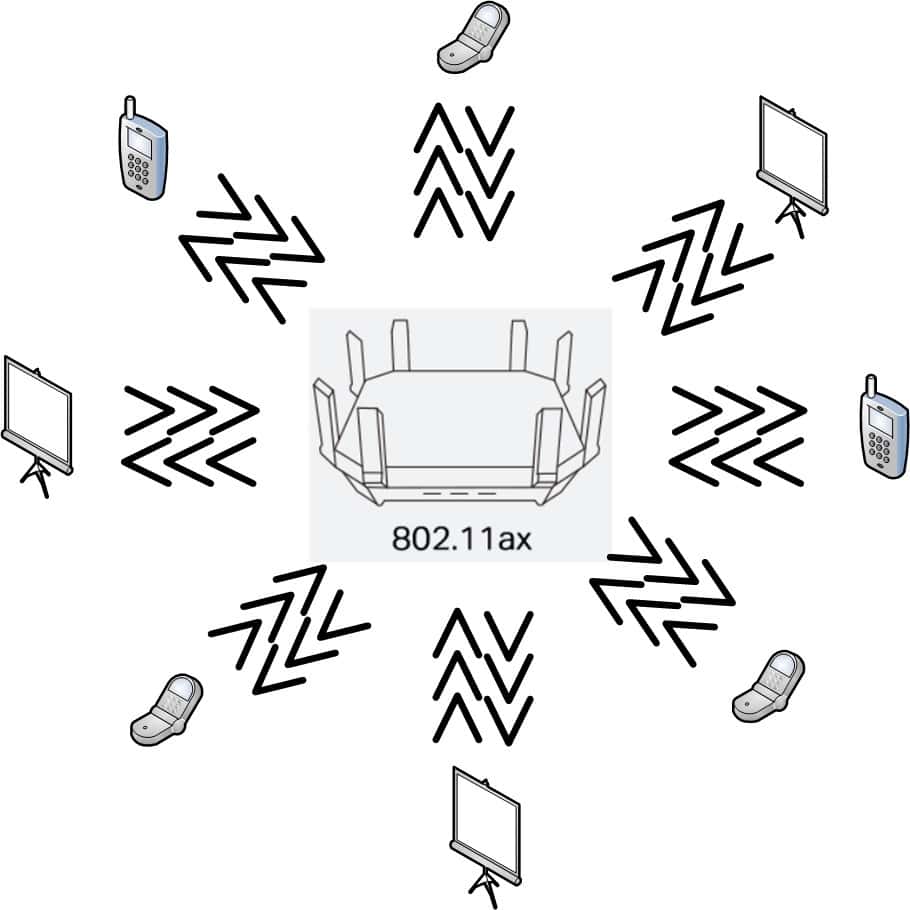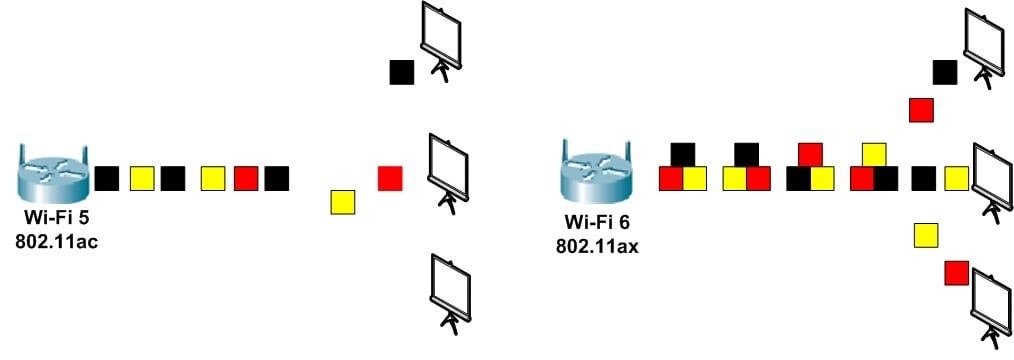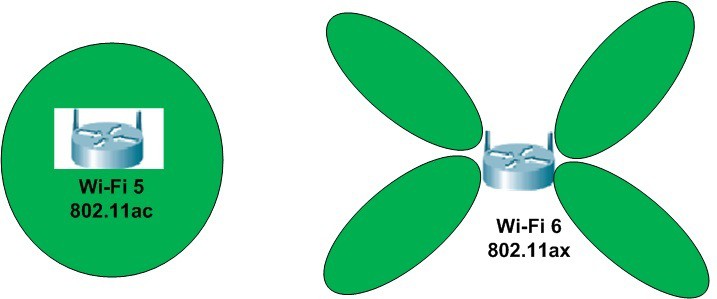1. Introduction
Wi-Fi 6, also known as 802.11ax, is the latest version of the Wi-Fi technology standard for wireless networks. It offers several advantages over previous standards, including faster speeds, better coverage, and increased capacity to handle more devices simultaneously.
In this tutorial, we’ll learn about Wi-Fi 6 technology in detail.
2. Wi-Fi Basics
Wi-Fi (short for Wireless Fidelity) is a type of wireless communication technology that enables electronic devices, such as computers, smartphones, and tablets, to connect to the internet or other networks without cables.
It transmits data by radio waves and is commonly used in homes, offices, public spaces, and other areas where people need to connect to the internet or share data wirelessly.
Wi-Fi technology is based on the IEEE 802.11 standards, which define the specifications for wireless local area networks (WLANs). These standards provide guidelines for the frequency band, modulation scheme, data rate, and other technical aspects of wireless communication.
3. What Is Wi-Fi 6?
Wi-Fi 6 is the most recent version of Wi-Fi technology. Its primary goal is to enhance the speed, coverage, and capacity of wireless networks in comparison to its predecessors: Wi-Fi 5 (802.11ac) and Wi-Fi 4 (802.11n).
3.1. Speed
Wi-Fi 6 can deliver speeds of up to 9.6 Gbps, which is significantly faster than the maximum speeds of 600 Mbps for Wi-Fi 4 and 3.5 Gbps for Wi-Fi 5:

Of course, achieving these speeds in the real world is challenging, and most devices can’t reach them in practice. However, Wi-Fi 6 still significantly improves speed and overall network performance, especially in congested environments with many connected devices.
3.2. MIMO
MIMO (Multiple-Input Multiple-Output) is a communication technology that uses multiple antennas at both the transmitter and receiver to improve the performance of wireless communication systems:

In this diagram, there are antennas at the transmitter (
) and receiver (
). The former uses multiple antennas to send data to the receiver, which also uses multiple antennas to receive the data.
In Wi-Fi 6, MIMO has been enhanced to support up to 8 spatial streams, compared to 4 streams in previous Wi-Fi standards. This allows even more data to be transmitted simultaneously, increasing network performance.
3.3. MU-MIMO
Wi-Fi 6 also introduces MU-MIMO (Multi-User Multiple Input Multiple Output), which enables multiple devices to transmit and receive data simultaneously using MIMO technology.
Traditional MU-MIMO technology allows multiple users to access the router simultaneously without experiencing any significant decrease in bandwidth quality. However, there’s a limit to the number of streams available for users to choose from. With the introduction of 8 x 8 MU-MIMO in Wi-Fi 6, users can choose from more than eight streams, double the number available in previous Wi-Fi standards.
One significant improvement of 8 x 8 MU-MIMO over the 802.11ac MU-MIMO is that the former works with both uploads and downloads. This means that users can enjoy faster upload and download speeds simultaneously. In addition, the increased number of streams and two-way communication capability makes Wi-Fi 6’s 8 x 8 MU-MIMO technology highly effective and efficient for handling heavy network traffic:

Therefore, multiple devices can connect to the same access point and receive data simultaneously without waiting for each other. MU-MIMO splits the available bandwidth into multiple spatial streams, which are then allocated to different devices based on their bandwidth requirements and signal strength.
3.4. Multiple Access
Wi-Fi 6 introduces a new technology called Orthogonal Frequency Division Multiple Access (OFDMA) to improve the efficiency of multiple access in wireless networks. OFDMA splits a single Wi-Fi channel into numerous sub-channels.
Each sub-channel has a different size and duration, allowing multiple users to share the same channel simultaneously. This reduces congestion and improves overall performance, especially in crowded environments where many devices compete for bandwidth.
An access point (AP) using Wi-Fi 6 can transmit data to multiple devices simultaneously using multiple antennas. In addition, OFDMA’s feature enables an AP to allocate sub-packets to different devices depending on their specific bandwidth requirements:

In Wi-Fi 5, each device must wait its turn to get the transmission. However, with Wi-Fi 6, each packet can carry pieces of data for multiple receivers. So, the data can be sent simultaneously to each device. As a result, data delivery is more effective, and there’s less lag.
Additionally, Wi-Fi 6 devices support spatial frequency reuse. It allows multiple devices to communicate simultaneously on the same frequency band without interference.
3.5. Beamforming
Beamforming is a technology that has been used in Wi-Fi for several years. However, it has been significantly enhanced in Wi-Fi 6 further to improve the performance and reliability of wireless networks.
In Wi-Fi 6, 802.11ax beamforming enables access points to dynamically adjust the direction and shape of the wireless signal better to match the location and movement of connected devices. This is done by analyzing the signal strength and then adjusting the signal path to improve the signal strength and reduce interference:

Wi-Fi 6 beamforming sends transmissions in specific directions that strengthen the signal. The older versions transmit the data in every direction uniformly.
Wi-Fi 6 can also minimize interference from nearby networks. It does this by using basic service set coloring (BSS).
3.6. Security
Wi-Fi 6 has introduced several new security features that enhance the protection of wireless networks.
The first of these is WPA3, the latest wireless security standard. It offers stronger encryption and authentication protocols than its predecessor, WPA2. With WPA3, users enjoy improved protection against password-guessing attacks. Furthermore, it boasts robust encryption protocols for safeguarding sensitive information and simplifies configuration for devices without visual interfaces.
Another new security mode introduced in Wi-Fi 6 is Enhanced Open. It allows devices to connect to a Wi-Fi network without entering a password. At the same time, it provides robust encryption to protect the transmitted data. In addition, opportunistic Wireless Encryption (OWE) is also available and provides encryption protection for open networks, which previously didn’t have any encryption.
Protected management frames add integrity protection to management frames, thereby preventing attacks that attempt to manipulate or disrupt the network. Target Wake Time (TWT) is a feature that allows devices to conserve power by scheduling their transmissions to avoid collisions with other devices. This feature reduces the risk of attacks that exploit network congestion to disrupt or interfere with communication.
Finally, Wi-Fi CERTIFIED WPA3TM is a certification program that ensures devices meet the latest Wi-Fi security standards. As a result, it provides users with greater assurance that their devices are secure.
Overall, these security features introduced in Wi-Fi 6 provide greater protection against various threats, making wireless networks safer and more secure.
3.7. Frequency Bands
Wi-Fi 6 operates in both the 2.4 GHz and 5 GHz frequency bands. However, it introduces a new 6 GHz frequency band called Wi-Fi 6E. This new band allows faster data rates, lower latency, and more bandwidth. Hence, it provides additional frequency channels unavailable in the 2.4 and 5 GHz bands.
The 2.4GHz band offers longer-range coverage and is less affected by obstacles. However, it has limited bandwidth and can be subject to interference from other wireless devices, such as Bluetooth and microwave ovens. The 5GHz band offers higher bandwidth but has a shorter range and can be more susceptible to interference from physical obstacles such as walls and furniture.
Adding the 6 GHz bands to Wi-Fi 6E allows for more bandwidth and less congestion. It also improves the Wi-Fi 6 frequency band by increasing the channel width from 80 MHz to 160 MHz:

In addition, it offers up to seven 160 MHz channels and enables wider channels, which can result in faster data rates and lower latency. However, the 6GHz band has a shorter range and may require more access points or routers for complete coverage.
3.8. Battery Life
Wi-Fi 6 can indirectly help improve battery life by reducing the time a device’s Wi-Fi radio needs to be active.
One of the ways Wi-Fi 6 improves battery life is through its use of TWT technology. TWT allows devices to schedule when they will wake up to receive data from the network rather than staying awake constantly. This can significantly reduce the time a device’s Wi-Fi radio is active, improving battery life.
Another way Wi-Fi 6 can improve battery life is through the use of MU-MIMO technology. MU-MIMO allows multiple devices to communicate simultaneously with a Wi-Fi router or access point. Hence, this reduces the time each device spends transmitting and receiving data. In turn, it reduces power consumption and improves battery life.
4. Wi-Fi 6 vs. Other Standards
Let’s compare the key features of Wi-Fi 4 (802.11n), Wi-Fi 5 (802.11ac), and Wi-Fi 6 (802.11ax):
Feature
Wi-Fi 4
Wi-Fi 5
Wi-Fi 6
Year of release
2009
2013
2019
Maximum speed
600 Mbps
3.5 Gbps
9.6 Gbps
Frequency bands
2.4 GHz and/or 5 GHz
5 GHz
2.4 GHz and/or 5 GHz
MIMO
Up to 4×4
Up to 8×8
Up to 8×8
Channel width
Up to 40 MHz
Up to 160 MHz
Up to 160 MHz
MU-MIMO
No
Yes
Yes
OFDMA
No
No
Yes
Beamforming
No
Yes
Yes
Wi-Fi 6 appears to be the best, but these are general features and capabilities. Therefore, performance may vary depending on the specific implementation and environment. Additionally, not all devices support all these features, even if they support the same Wi-Fi standard.
5. Conclusion
In this article, we talked about Wi-Fi 6.
Wi-Fi 6 is the latest generation of Wi-Fi technology that offers significant improvements over its predecessors in speed, capacity, and efficiency. It uses advanced features such as MU-MIMO, OFDMA, 802.11ax beamforming, and BSS Coloring to enable faster and more reliable wireless connectivity, especially in high-density environments.
With Wi-Fi 6, users enjoy higher speeds, lower latency, and improved performance for a wide range of applications, from streaming high-quality video content to connecting multiple smart devices simultaneously.